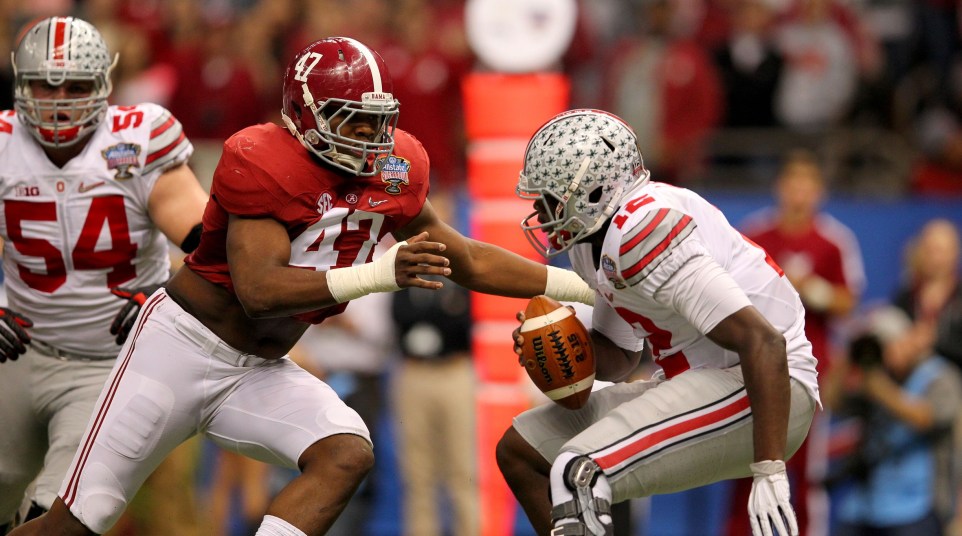Alabama could use difference-making pass rusher at linebacker
The Crimson Tide defense has regressed from all-time great (2011) to best in the country (2012) to great, but vulnerable (2013) to very good (2014).
Multiple factors have contributed: the evolution of offensive tempo, rules changes that ding physical defenses, an inability to develop talent at cornerback and fewer transcendent players in the front seven.
It’s not as if Alabama’s defense is in crisis mode — the team finished sixth in the country by allowing 18.4 points per game last year. Everything is relative in Tuscaloosa. But championship-caliber offenses have torched the Tide, like Johnny Manziel’s 2012 Texas A&M team, Oklahoma’s aggressive Sugar Bowl plan following the 2013 season and Ohio State in the College Football Playoffs in January.
Despite losing its top three safeties, Alabama has to be optimistic about a bounce-back from the secondary with a wealth of young five-star talent at cornerback. Even Alabama can’t produce a Top 15 pick at linebacker or defensive line every single year, but coach Nick Saban’s “Process” and recruiting ability ensure the team can count on some more transcendent players there in cyclical fashion.
Perhaps the biggest thing the program could do to shift the paradigm? Find or develop an elite pass rusher at linebacker.
In many ways, that would require a shift in philosophy that Saban may not be willing to embrace.
Traditionally, Alabama prefers to find three-down players who are good enough to suffocate the most physical run offenses in the SEC, and also athletic enough to disrupt the passing game in coverage or by pressuring the quarterback. In reality, even for the best recruiting program in the country, that’s more of a rarity the more difficult it becomes to defend today’s track meet offenses.
The Tide’s best pass rusher in the Saban era may have been Courtney Upshaw. At 6-foot-2 and 265 pounds, he fit Alabama’s run defense as the No. 1 priority, a stout, physical player who could just as easily knock an offensive lineman on his backside, crunch a thick running back or speed past a left tackle, chase down and sack a quarterback executing a five-step drop.
A unique physical profile even for an NFL player (by his pro day, he weighed 272, and still was relatively fast), Upshaw represents an anomaly, not the kind of template around which Alabama can build its pass rush. Ohio State’s Joey Bosa is slightly bigger than Upshaw and plays defensive line, but he’s an example of a player that the Tide recruited with similar attributes.
The faster and more athletic offenses get, the fewer defensive ends and linebackers are good enough to play both the run and the pass at an All-American type level. Any weakness gets exposed.
The Tide would seem to recoil at the thought of developing a Shane Ray type, worried about sacrificing its physicality in the run game. It’s not as if the team’s pass rush is awful. Xzavier Dickson and Ryan Anderson combined for 12 sacks in ’14 from the team’s linebacker position that most closely resembles a pass-rush specialist.
But Trey DePriest — though he played with an injured knee and he’s a middle linebacker, not a pass rusher — is a perfect example of Bama’s weakness in the defensive front seven. Smart and talented offenses were able to exploit his lack of agility and speed in pass coverage.
Despite its obsession with three-down players, the Tide does have a few third-down pass rush packages, one of which Anderson played pretty effectively last season. Again, it’s not as if Alabama has been awful — it’s all relative — but look at what players like Texas A&M’s Myles Garrett and Tennessee’s Derek Barnett accomplished in their true freshman seasons last year.
Garrett especially gave up some ground as a run defender, and wasn’t quite strong and physical enough to handle the SEC’s top-end offensive tackles. But he broke Jadeveon Clowney’s SEC freshman sack record, and gives that A&M defense a different dynamic.
It’s not as if Alabama’s run defense is going to tank if the team can find one or two players whose development is skewed toward pass rush, especially if those players are nationally elite at getting after the quarterback. Too many times in the last two or three seasons, the Tide defense doesn’t have enough quick-twitch players who can move fast enough to disrupt quarterbacks who get rid of the ball quickly and start the subsequent play in a hurry.
The Tide generally get just about whatever the team wants in recruiting, so it may be a matter of intentionally targeting four or five of the best pure pass rushers in the country starting in ’16, regardless of how they fit Alabama’s scheme or whether they’re ready to be elite run stuffers in the SEC as underclassmen.
An elite pass rusher at linebacker or even at defensive end could mitigate a lot of the minor issues that have crept into Alabama’s defense in the last three years.

